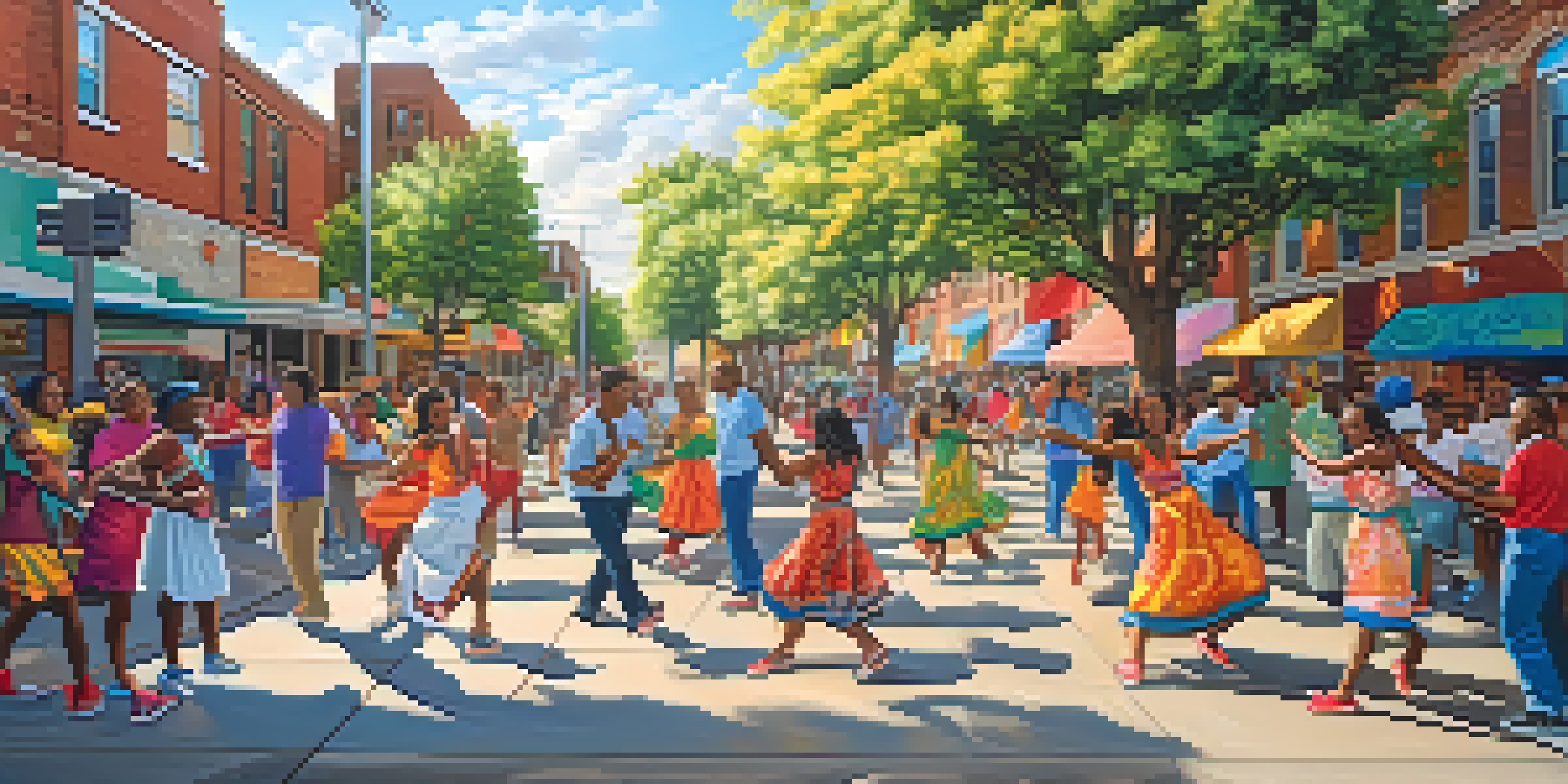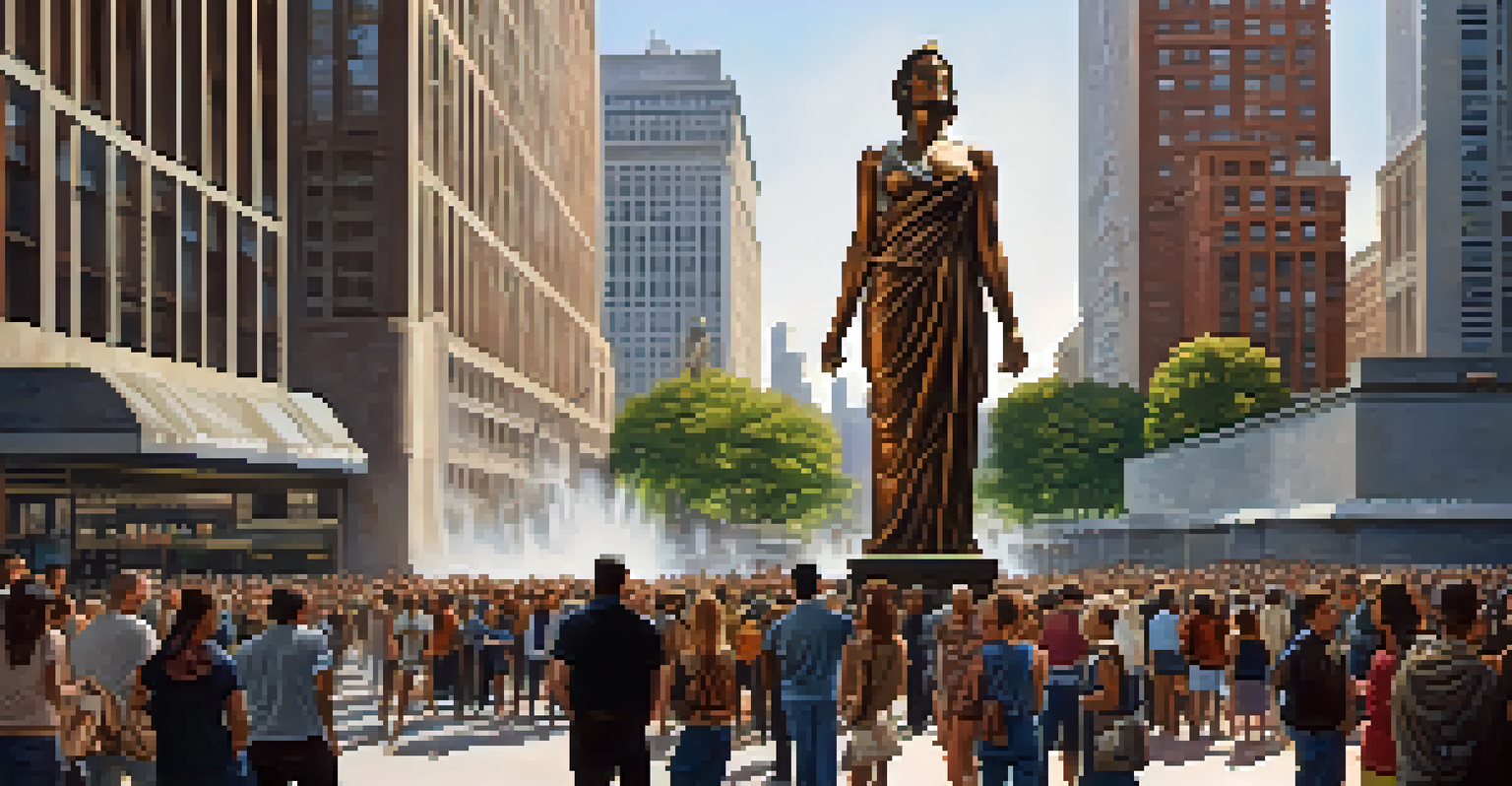Public Art Projects That Challenge Social Norms

The Role of Public Art in Society
Public art serves as a mirror reflecting societal values and challenges. It can provoke thought, spark conversations, and inspire change, all while being accessible to everyone. Unlike traditional art, which may reside in galleries, public art interacts with the community daily, making it a powerful tool for social commentary.
Art is not freedom from discipline, but disciplined freedom.
Take, for instance, the famous 'Fearless Girl' statue that faced off against the 'Charging Bull' on Wall Street. This sculpture not only celebrates female empowerment but also questions the male-dominated corporate culture. Such installations act as catalysts, prompting viewers to reconsider their own beliefs and biases in a public space.
Through the lens of public art, artists can address pressing social issues like inequality, climate change, and identity. These projects often resonate deeply with local communities, encouraging reflection on shared challenges and aspirations, and ultimately fostering a sense of unity.
Street Art: A Voice for the Voiceless
Street art has emerged as a vital form of expression for marginalized groups. Artists use the urban canvas to voice their struggles and dreams, often bypassing traditional art gatekeepers. This raw form of creativity challenges social norms by presenting alternative narratives that may otherwise remain unheard.

Consider the impactful work of artists like Banksy, whose satirical pieces comment on war, consumerism, and social injustice. His art often appears unexpectedly, inviting passersby to confront uncomfortable truths. This immediacy allows viewers to engage with the message in a way that feels personal and urgent.
Public Art Sparks Social Change
Public art serves as a catalyst for dialogue and reflection on societal values and challenges.
Moreover, street art fosters community engagement by turning neglected spaces into vibrant cultural hubs. Murals and graffiti can transform a dull alley into a gallery, encouraging dialogue and connection among residents. In this way, street art not only challenges norms but also revitalizes communities.
Installations That Spark Dialogue
Some public art projects go beyond visual appeal, prompting critical conversations about societal issues. Installations like 'The Obliteration Room' by Yayoi Kusama invite viewers to actively participate, making them part of the art. By allowing attendees to add their own colorful dots, the piece evolves into a collective expression of creativity and identity.
Public art is a bridge between the community and artists, creating dialogue that reflects our shared humanity.
These interactive elements invite people to reflect on their own experiences and perceptions. As participants contribute, they engage in a dialogue about ownership, community, and the transformative power of art. Such projects challenge the traditional notion of the spectator, blurring the lines between artist and audience.
In essence, these installations not only beautify public spaces but also foster a sense of belonging and shared responsibility. They remind us that art can be a communal experience, encouraging us to rethink our role within our communities and the world at large.
Art and Environmental Awareness
Public art can also serve as a powerful advocate for environmental issues. Projects like 'The Floating Piers' by Christo and Jeanne-Claude invite people to experience nature in new ways, promoting a deeper connection to the environment. By creating temporary structures that blend art with the landscape, they challenge viewers to reconsider their relationship with nature.
Similarly, installations like 'The Trash Isles' highlight the global plastic crisis, transforming waste into art. This project not only raises awareness but also encourages individuals to confront their consumption habits. By turning trash into a visual statement, artists challenge us to reconsider the impact of our actions on the planet.
Street Art Amplifies Marginalized Voices
Street art provides a platform for underrepresented groups to express their struggles and foster community engagement.
Through these environmentally-focused projects, public art becomes a call to action. They inspire us to take responsibility for our surroundings and advocate for sustainable practices, reminding us that art can be both aesthetically pleasing and socially conscious.
Challenging Gender Norms Through Art
Gender norms have long been a target for public art projects that seek to challenge traditional roles. Artists like Judy Chicago have used their work to highlight women's contributions throughout history, pushing back against patriarchal narratives. Projects that celebrate femininity and challenge stereotypes can empower viewers to rethink gender expectations.
For instance, 'The Dinner Party' is an iconic installation that features place settings for 39 influential women, reclaiming their stories in a male-dominated art history. Such projects not only educate viewers but also inspire conversations about gender equality and representation.
By confronting societal norms related to gender, public art fosters a more inclusive dialogue. These works encourage individuals to question their own biases and consider how they can contribute to a more equitable society.
Art as a Platform for Political Expression
Public art often serves as a platform for political expression, challenging the status quo and advocating for change. Artists use their work to comment on current events, social justice movements, and human rights issues. This form of activism transforms public spaces into arenas for political dialogue.
A notable example is the 'Black Lives Matter' mural in Washington, D.C. This powerful statement not only honors the movement but also invites discussions on race and equality. By placing these messages in prominent, public areas, artists elevate important conversations that might otherwise be sidelined.
Art Drives Environmental Awareness
Public art projects raise awareness about environmental issues, encouraging individuals to rethink their relationship with nature.
These politically charged artworks remind us of the power of art as a tool for social change. They encourage viewers to engage with pressing issues and inspire collective action, reinforcing the idea that art can be a catalyst for transformation.
Community-Driven Art Projects
Community-driven art projects play a crucial role in challenging social norms by fostering collaboration and inclusivity. These initiatives often involve local residents in the creation process, ensuring that their voices and stories are reflected in the final artwork. This participatory approach empowers individuals and strengthens community bonds.
An example is the 'Chicago Public Art Initiative,' which brings together artists and community members to create murals that celebrate local culture and history. By highlighting the unique narratives of a neighborhood, these projects challenge stereotypes and promote a sense of pride among residents.

Through collaboration, these art projects not only beautify public spaces but also encourage dialogue about social issues. They remind us that everyone has a story worth sharing, and when communities come together, they can create powerful statements that challenge societal norms.